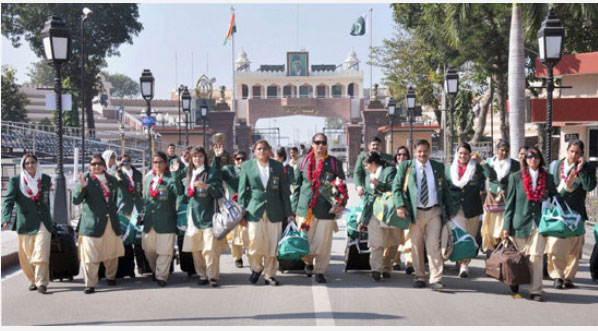Move over cricket, for in Punjab’s heartland and in high-profile gatherings in Canada, UK, USA and some European countries, kabaddi is king. Believe it or not, the rural sport, which is played predominantly in Punjab and mostly by Punjabis all over the world, has an annual budget of Rs. 200 crore,
comparable only to cricket in India. In fact, many kabaddi players earn more in a year than some of India’s best domestic cricketers.
The Punjab government initiated the Kabaddi World Cup in 2010, which entered its fourth edition on Saturday, carrying a total prize money of Rs. 6.67cr. With the World Cup, the sport has seen a further boost in terms of investment and found takers outside India. Kabaddi is now pursued even in Kenya and Sierra Leone in Africa. “There is a huge Punjabi population in Canada, USA and Europe. So kabaddi has a good fan following there. The patronage of NRIs over the years has made this form (circle kabaddi) a million-dollar sport,” says Karan Singh Ghuman, owner of the International Punjab Sports and Cultural Club in Toronto.
Big budget
The budget of kabaddi in Canada is almost Rs. 50cr, and in England, it touches Rs. 25cr. “The Kabaddi World Cup is also adding in a major way to the present scenario of the sport. Because of this, kabaddi has got centrestage in Punjab and the players are earning more than what they used to when they were playing professional leagues in Canada and other countries,” adds Ghuman.
Kulwinder Singh, who belongs to Kapurthala and is a former captain of Canada, had gone there in the early ’90s to play professional kabaddi for a Vancouver club and later settled there after marrying a Canadian citizen. His point is explained by figures that suggest that a player who plays professional kabaddi either in Canada, England, USA or Europe over the summer and later joins the Indian season (from November to March), earns a minimum of Rs. 6 – Rs. 8 lakh per year, with the best earnings being between Rs. 40-Rs 80 lakh, including gifts in kind.
Good living
“I’ve now played five seasons in Canada after playing as many in England and I can afford a luxurious lifestyle,” says Ludhiana-based Manjit Sehoura.
In Canada and UK, the sport is hugely popular, both having a well-structured professional club circuit. The four-month season that starts in May in Canada witnesses as many as 350 players slugging it out, of which around 150 are overseas.
Toronto has 16 clubs and Vancouver has 12. Unlike top level European football, matches are played on weekdays attracting 5,000-odd spectators on an average.
“Every club in Canada and England has an annual budget ranging from `1-2cr. Every year, around 200 players from Punjab fly to these countries for the professional leagues. With each passing year, the players are earning more money,” says Ghuman, adding, “To improve our base in the sport, we have introduced under-21 competitions since last year and have 10 junior teams now.”
Countries such as Italy, Norway and Germany also have kabaddi clubs where leagues are played on a regular basis and offer a decent purse. It’s easy to gauge the stakes in the sport when one learns of the amount earned by commentators. “A decent commentator earns about R3 lakh from the Indian circuit and another R3 lakh if he goes to Canada or England. Kabaddi commentary is a full-time profession and my only source of income,” says Satpal Singh from Sangrur who visited Canada last year to cover kabaddi matches.
Cup coverage
All World Cup matches till date were telecast live on PTC which also reaches out to Canada, UK and USA. Over the seasons, the World Cup has raised its glamour quotient with Shah Rukh Khan, Akshay Kumar, Katrina Kaif and Priyanka Chopra performing during the opening and closing ceremonies.
“Punjab has a culture of rural sports and most large villages host festivals in which kabaddi matches hold centrestage,” says Sukhdarshan Singh Chahal, a kabaddi statistician who has written five books on the sport. “Because of the money, an increasing number of youngsters want to be a part of kabaddi, which helps the sport have a broader pool.”
Ravinder Singh Jassal, president of the Sierra Leone Kabaddi Federation, is responsible to a large extent for popularising the sport in his adopted country. “I played kabaddi in college. Later, when I shifted to Sierra Leone, I found that the natives could be good kabaddi players as the game requires strong physique and a good grip. So, I approached the local wrestling club, bouncers at nightclubs and security guards to be a part of the sport,” says Jassal. Initially, he found it difficult to help them integrate, having even had to bear their cost of travel and pay for their diet. “But now, we have proper teams of both men and women. Because of us, the sport has a base in Kenya too,” claims Jassal.
Dope menace
Since circle kabaddi is not a part of any multi-discipline event, there are very few checks in place. Anti-doping measures is one of them. In the inaugural season, there were 16 dope offenders. In 2011, the number rose to 53 — the highest for any sporting event in the world. Even during the trials for the World Cup squad, 20 players failed dope tests with many more running away. It improved last year with the number reduced to five.

